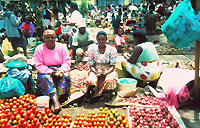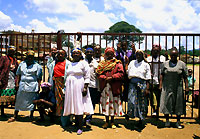In Kenya, most market traders selling agricultural products are women. They perform both business and social activities in the markets. The Kenyan Government has adopted structural adjustment programs since the early 1980s, and local authorities have developed and enforced new policies to promote the distribution system for agricultural products and to encourage micro-scale enterprises. As a result, local market places started to be directly and rapidly connected into the global economy. Machakos District, where I have conduced my field research, bounds on Nairobi, the capital city of Kenya. The area is inhabited by Kamba people (Akamba), whose livelihoods are based on agriculture. From the early 1990s Machakos Municipality started relocating markets and setting regulations with regard to business hours, and started to collect fees and charges. The Municipality also tried to make a clear distinction between wholesalers and retailers, with the aim of exerting control over and promoting marketing products. However, some of the new regulations met firm resistance from the market women, because they infringed on their ability to carry out income-generating activities. The strategies of resistance involved noncompliance and negotiations. For example, potato wholesalers conducted repeated negotiations with the Municipality concerning how big or small their selling units could be. In response, the Municipality eventually made a number of concessions to them, making it easier for them to pursue their own ways of business. This case suggests that local authorities cannot one-sidedly force regulations onto businesses. The reciprocal relationship between the ruling authority and the ruled plays a critical role in establishing these regulations. (3)The research period was from 14 January to 31 March 2003. I collected some official documents and processed data in Nairobi, and conducted field research in Machakos. The findings of the research are as follows: 1. I held interviews with three major micro-finance (MF) institutions about the objectives of their operations and business conditions. The preliminary results show that MF in Kenya, which was originally introduced as a tool to alleviate poverty, functions as part of the financial system now. This change resulted partly from a universal trend of transforming MF bodies from aid agencies to financial institutions. This change was also promoted by a policy switch of the Kenyan Government since the late 1990s, involving the liberalization of the financial system by amending the Banking Act and MFI (micro-finance institution) Act. The number of MF institutions is increasing, and there are now about 50 in Kenya. Competition for customers is intensifying.I will examine the development process of these voluntary associations and how market women utilize them as well as MF. I will also discuss the influences and impacts of the expansion of MF and changes in government policy on the evolution of voluntary associations. |


 21st Century COE Program
-Aiming for COE of Integrated Area Studies-
21st Century COE Program
-Aiming for COE of Integrated Area Studies-